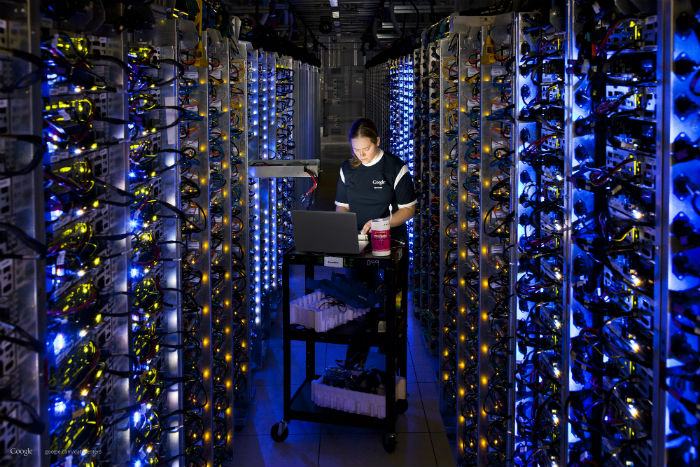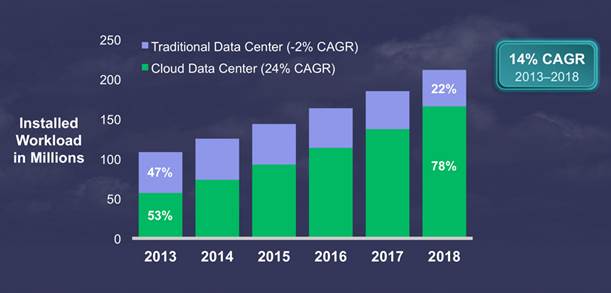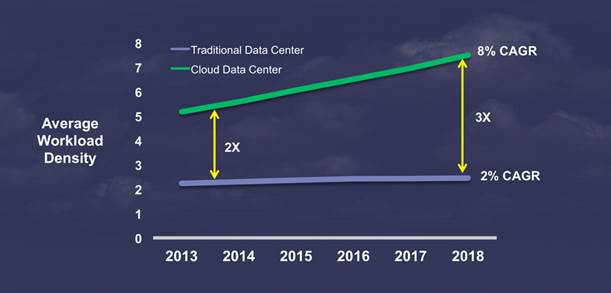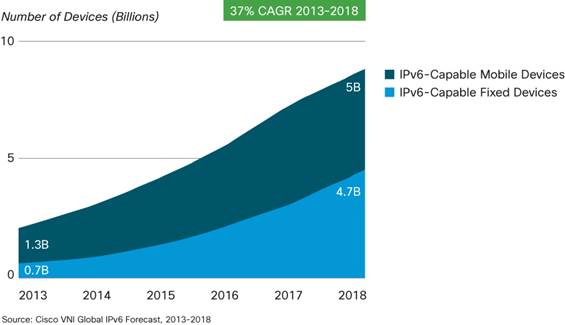What to expect in 2015: Data Center World Trends

The end of the year is a traditional time for summing up and thinking about trends in the near future. In today's article, we will discuss some trends in the data center world that experts in companies such as Cisco (and other experts) have noted in their research.
Internet of things gets to data centers
The Internet of Things (IoT) and the Internet of Everything (IoE) is a global trend that will not bypass data centers in the coming years. This is well illustrated by statistics :
- By 2020, 30 billion devices will be connected to the network, and the amount of data generated by the “Internet of all” will be 403 zettabytes (ST) per year by 2018 (in 2013 there were 113 ST).
- By 2018, IoE devices will generate twice as much data as end users transmit to data centers, this amount will be 47 times more than the total data center traffic.
- About 2% of the data generated by IoE devices will eventually reach data centers (this opens up opportunities for increasing data storage capabilities).
Data streams
In 2015, more than 90% of all Internet traffic will be on video (including HD and 3D) - this will also affect what data will be transferred to and from data centers.
Next year, data center traffic will exceed five zettabytes, and 76% of this data will not leave the data center walls - thus, internal traffic will be the largest segment of all the transmitted information. However, the traffic between data centers will increase, and its growth rate will be 25% faster than the rate of increase in traffic between end users and data centers or internal data center traffic.

Data centers will increase and decrease
Many Western experts agree that the next year will be marked by a change in the size of the data center. At the same time, there will be a trend towards consolidation of large-scale data centers and reduction in the area of small data centers. This is how Dimension Data expert Kevin Leahy describes this situation.
Small corporate data centers will seek to reduce the footprint, large providers of collocation services will only grow.
Cloud technology plays a big role in reducing corporate data centers. A year or two ago, business representatives were thinking about whether they were ready to introduce clouds or not. Now this question is no longer standing - now the business is thinking about how to benefit from new technologies. What to transfer to the cloud? How fast can such a migration be? Organizations that ask themselves such questions overestimate the waste of resources on maintaining their own data centers, including thinking about saving physical space, often it ultimately decreases by half.
At the same time, large data centers continue to grow. These companies invest heavily in cooling and energy saving technologies, so the efficiency of using the computing resources of a physical server in such data centers is much higher than a private company can achieve in its own data center.
Development of public and private clouds
Cisco experts in their report “ Cloud Index Report ” highlight several facts related to the development of cloud technologies:
- In 2015, 70% of the load will be on cloud data centers, and their traffic will grow four times faster than the traffic of traditional data centers.
- By 2018, more than three quarters (78%) of the entire load will be on cloud data centers, and only about a quarter (22%) - on traditional ones.
- The load of public clouds will grow 50% faster than private ones - by 2018, 53% of Internet users (2 billion people) will use personal cloud services for data storage (in 2013 this figure was 38% or 922 million people).
- By 2018, 31% of the cloud load will fall on public cloud data centers (in 2013 it was 22%), and 69% on private cloud data centers (in 2013 it was 78%).

Continued virtualization technology penetration
One of the main factors that will facilitate the migration of load from traditional data centers to cloud data centers is a significant degree of virtualization of the latter, Cisco is convinced . Virtualization allows you to dynamically allocate resources to the needs of the business.
In addition, virtualization leads to an increase in server load density - this indicator for cloud data centers will grow from 5.2 in 2013 to almost 7.5 in 2018. At the same time, for traditional data centers, the increase will not be so significant - from 2.2 in 2013 to 2.5 in 2018.

IPv6 penetration
Another Cisco document titled “ The Zettabyte Era - Trends an Analysis ” specifically notes that IPv6 penetration will continue in 2015. Asia and Europe have already used up their dedicated IPv4 address pools, and in North America, Africa and Latin America, free addresses will run out between 2015 and 2017.
According to Cisco estimates, by 2018 there will be 10 billion devices (fixed and mobile) supporting IPv6 in the world (in 2013, this figure was only 2 billion).

According toan IPv6-enabled organization called the World IPv6 Launch Organization, back in April 2014, many large operators and Internet service providers introduced IPv6 and reported an increasing amount of traffic using the new technology: up to 49% on the Verizon Wireless network, French Free Telecom claimed 37.52%, the Romanian RCSand RDSat about 24.86%, AT&T - about 17.88%. In 1cloud, we also plan to introduce IPv6 support in the infrastructure in 2015 .
The appearance of public API data centers
The development of clouds leads to the emergence of technologies that make it more convenient to use clouds for business tasks. One such tool is the public API for interacting with data centers. Using this technology, you can connect various applications and physical platforms that can be located at different points in space.
Such integrations can be carried out at the infrastructure level (distribution of cloud resources), the application level (for example, integration with the cloud of CRM and ERP systems) or the service level (integration with databases, messaging systems, portals, etc.). In addition, since organizations rarely work with a single data center or cloud service provider, there may often be a need to integrate these distributed services - here public APIs also come to the rescue (in 2015, 1cloud will have its own API, which we will do about separate topic for Habr).
That's all for today! Thank you all for your attention, we will be happy to answer questions in the comments.
